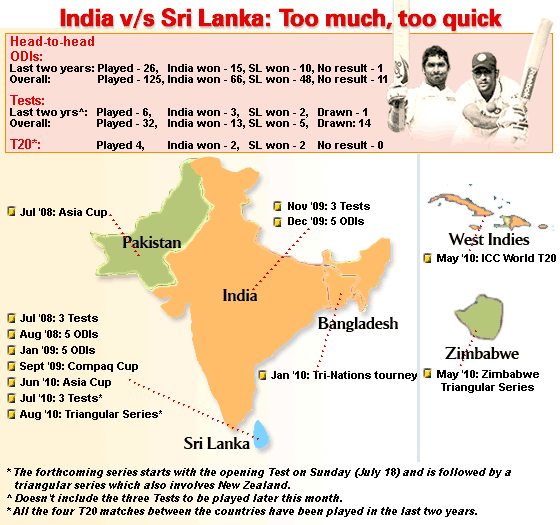The increase in frequency of matches between India and Sri Lanka, says Bikash Mohapatra, has killed the charm and excitement that accompanied matches between the sides a few years back
Twenty-six ODIs, six Tests and four T20 internationals.
That is the precise number of instances when India played Sri Lanka. All of these meetings were in the last two years (see graph).
And three Tests and an equal number of one-dayers are on the anvil.
Call it that neighbourly feeling, lack of cricketing opponents or simply an overdose.
Blame it on the two boards, the upsurge in television channels or an increasing number of sponsors -- each keen to have a share of the pie -- the fact remains that the two countries have played each other more frequently in the last two years than they ever did.
In recent months there was a tri-nation series -- also featuring hosts Zimbabwe -- and the Asia Cup, and in the coming weeks one will witness the two neighbours playing three Tests before being joined by New Zealand for a triangular series.
This is certainly not the end of it.
The possibility of a bilateral -- or for that matter tri-lateral -- series - in the near future can never be ruled out.
And if the respective boards and sponsors are happy making the moolah there are others for whom this excess has ensured ennui.
"It's boring," says cricketer-turned-commentator Madan Lal categorically.
"Every time you switch on the television it is India versus Sri Lanka.
"I don't know why they play so much. I am not in favour of playing with one country too often," he adds.
The point seems valid.
Is it imperative for Team India to play so much, so soon against Sri Lanka?
At a time when there are complaints from various quarters with regard to excessive cricket in recent times, there are two nations who don't mind playing each other as frequently as possible.

Consider this:
Taking into account the statistics above, there were four bilateral series between India and Sri Lanka in the last two years -- including the upcoming series. Besides, they have faced each other frequently in various three-nation tourneys and other international events.In the same period, India's match ratio against the other countries is far more believable.
The team has featured in two series against Australia -- the Test series in 2008 and the ODI series last year -- while also playing Bangladesh, England, New Zealand, South Africa and West Indies once each.
The existing political scenario has limited its clashes with arch rivals Pakistan to only international events.
In fact, the five-match ODI series in Sri Lanka in last January was an ad hoc arrangement to make up for the cancellation of the scheduled tour of Pakistan.
To be blunt, it did not make much sense considering the team had already played an equivalent number of matches against its southern neighbour just a few months earlier.
However, there is no explanation to this excess, the reasons offered are obvious but not convincing.
"What can the players do when the board decides likewise," says Madan Lal, laying the blame on the obvious.
There are others who successfully draw an analogy.
"If you remember, during the early part of the last decade (before the political tension) we played a lot against Pakistan," reasons former national selector Kiran More.
"So I don't think it makes any difference," he adds, rather nonchalantly.
This increased frequency also ensures a player's frailties are exposed to the opposition, but experts believe that might actually be a virtue than a vice.
"The same is applicable in the case of both the teams," reasons More, adding, "If a team is good enough it will continue to improve despite the opposition's familiarity with its players."
Madan Lal concurs. "The frequency does help you to an extent," he explains, before putting in a word of caution.
"If our team is playing so much against the Lankans it should always perform well against them. But that is not always the case," he adds.
A glance at the record books suggests that India has had the upper hand against its neighbour, but only marginally.
And, in the process, the two teams have become more aware than ever of each other's strengths and weaknesses, something that might not be necessarily good.
"At the moment there's a marginal difference between India and Sri Lanka," explains More.
"If they are better than us as regards bowling and fielding, we are far ahead of them in the batting department," he adds.
For better or worse, the increase in frequency of matches between India and Sri Lanka is a fact that has to be accepted, even if with a pinch of salt.
This might have killed the charm and excitement that accompanied the meetings between the sides a few years back, but the parties concerned with the organisation of the same seem rather unconcerned.
So get ready to cheer your favourite team for the next month-and-a-half.
And don't worry if the results aren't on expected lines. There will be another India-Sri Lanka series in the near future.
Illustration: Uday Kuckian






